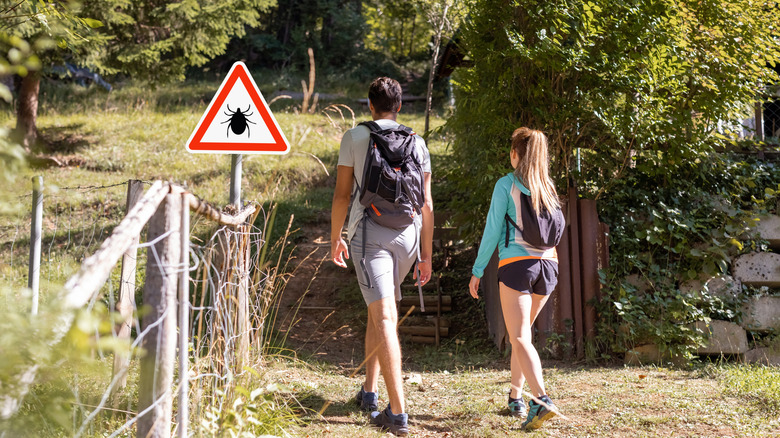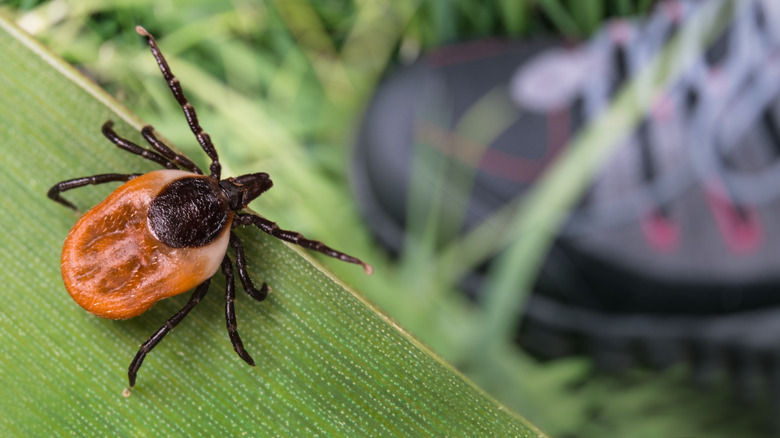This Park Ranger-Approved Hack Is A Quick And Easy Way To Get Rid Of Ticks While Hiking
We may receive a commission on purchases made from links.
America has no shortage of gorgeous hiking trails to do, especially in the summer, which is one of the best times to explore them. But don't get distracted by the beautiful sights around you for you may unknowingly be sharing these trails with some serious pests — and I'm not talking about inconsiderate hikers. Ticks are abundant around many hiking trails, and like many humans, they love coming out to play in the summer. These creatures may be tiny, but the problems they cause are anything but. While they don't pack much of a bite, they may be carrying diseases that can easily spread to humans and other animals. Even worse than encountering them on the trail would be to bring ticks home with you and have them hide out in your clothes and furniture. Fortunately, park rangers recommend packing an everyday home item for your trip outdoors to help you prevent that.
Before coming home from a hike, use a lint roller — the kind with the sticky paper that you can easily throw away, like these from Polardo – and pass it over your clothes a few times. This handy little tool is a must when packing for camping, hiking, or backpacking trips. The sticky paper will catch ticks and other bugs hitching a ride on your clothes, giving you some peace of mind until you're able to do a more thorough check. This odd but easy hiking hack can be an actual life-saver, and a good way to keep yourself and those around you safe.
Avoid getting ticks while hiking
While packing a handy-dandy lint roller to get ticks off your clothes is a smart idea, taking preventative steps to avoid ticks in the first place is even better. You can try a plethora of simple tricks to avoid tick bites on your next hike. The first step is to do some research on where you're hiking to determine the likelihood of encountering ticks. Be extra cautious during spring and early summer, as this is the time when ticks are in the developmental phase where they're more likely to carry heavier loads of disease-causing pathogens. This is also when they are smaller in size and can be harder to spot. Avoid areas with tall grasses and brush because they make it easier for ticks to crawl onto hikers.
You should also be proactive about what you're wearing. Long-sleeve shirts, long pants, and light colors are the way to go. Ticks are easier to spot on light colors, while exposed skin gives ticks easy access. Tuck your shirt into your pants and tuck your pants into your socks to seal any gaps that may allow ticks to squeeze their way through. Lastly, be sure to douse your clothes and exposed skin in repellant. A chemical called permethrin may be your best option here, as it can repel ticks and other insects for up to two weeks.
Check for ticks after your hike
The final and perhaps most important step in preventing any tick-related disasters is to diligently check yourself when you return from your hiking or camping trip. At this point, you've hopefully already used the lint roller trick and are ready to diligently check your clothes. Take some time to inspect every article of clothing you wore, right down to your socks and undergarments. Then throw your clothes in the washer and wash them in hot water and tumble dry them on high heat. The temperature setting is important because cold or lukewarm settings are not going to be enough to kill the ticks.
Once you've moved on from your clothes, do a quick check on every part of your body. Remember, ticks can be really small, so take your time on this part and don't be afraid to get comfortable with a mirror. Check behind your knees, around your elbows and armpits, behind your ears and neck, and anywhere that grows hair. Once you're satisfied, hop into the shower to wash away any lingering ticks you may have missed. If you brought a furry friend on your hike, don't forget to give them a thorough check as well.


